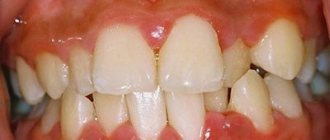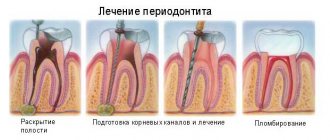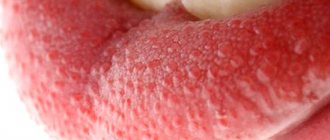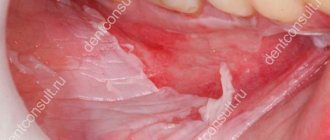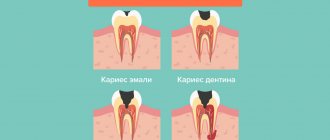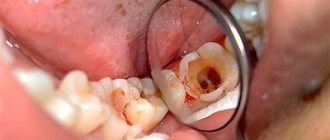Chronic periodontitis is one of the forms of the disease that occurs due to the fact that pathogenic microorganisms penetrate into the periodontal tissue through the openings of the root canals located at the tops of the dental roots. Chronic periodontitis of the roots is accompanied by a violation of the integrity of the ligaments that provide fixation and stability of the tooth, destructive processes of bone tissue and can lead to the formation of granulomas and large cysts.
Chronic periodontitis is a pathological process in the periodontal tissues. This is associated with the development of inflammation in the periodontium and the formation of fibrous, granulating, granulomatous tissue. In the chronic form of the disease, exacerbations periodically occur, during which swelling of the gums, loosening of teeth, the appearance of fistulas with the release of pus, etc. are observed. Specialists identify this pathology and distinguish it from similar diseases using electroodontometry, X-rays and visual examination. Lack of proper treatment leads to tooth loss due to weakening of the ligamentous apparatus and the growth of large capsules with pus.
Filling made of light-curing material for classes I and V - 2,000 rubles.
Filling made of light-curing material in classes II, III, IV - 3,000 rubles.
Placing a temporary filling - 400 rubles.
Resection of the root apex (frontal group) - 6,500 rubles.
Resection of the root apex (chewing group) - RUB 9,000.
Mechanical and medicinal treatment of canals for periodontitis (1 canal) - 1,100 rubles.
Closing perforations (MTA) - RUB 6,500.
At CELT you can get advice from a dental specialist.
- The cost of a dental consultation is 1,000
- The cost of an orthodontist consultation is 2,000
Make an appointment
Symptoms of the disease
General symptoms depend on the form of the pathology. When granulomas form, attacks of pain are observed when exposed to hot food. Pressure on the affected tooth and gum is accompanied by pain. The size and density of the mucosa in the affected area changes, and a granuloma forms under the bone or mucosa.
An exacerbation is accompanied by the appearance of fistulas, which grow and gradually release their contents into the oral cavity. In this case, purulent fistulas can appear not only on the gums, but also on the cheekbones, cheeks, neck, and chin. Isolation of pus may be performed along with the isolation of granulosa tissue. Then the fistula goes away, and a scar appears in its place.
The granulomatous form occurs for a long time without pronounced symptoms. Only after the granuloma grows to a large size and cysts form, the main symptoms appear: discoloration and severe pain in the tooth, development of gumboil and swelling of the gums in the affected area. Cysts that are too large can cause a jaw fracture and long-term rehabilitation.
Fibrous periodontitis is the most hidden form of pathology. There is no pain when chewing food or drinking hot drinks. Severe symptoms are observed only during exacerbation. There is general poisoning of the body due to the penetration of pus into the blood, the tooth becomes loose, and the lymph nodes in this area become larger.
Age restrictions
Periodontitis can occur in a person of any age, and there are no age restrictions for its treatment. Pregnant women are treated with special care, since, on the one hand, periodontitis is a dangerous source of infection that reduces immunity and can threaten the adequate course of pregnancy, and on the other hand, highly effective drugs with a strong effect can also threaten the development of the fetus. Therefore, treatment of periodontitis during pregnancy and lactation is carried out using the most gentle methods and drugs. But in order to prevent such situations, it is necessary to carry out routine monitoring, sanitation and medical examination at any age, and even more so during periods of pregnancy planning, as well as the prenatal period.
Causes of chronic periodontitis
Chronic periodontitis appears in the absence of treatment of the acute form. The disease develops due to traumatic, toxic, infectious, mechanical effects on tissue.
The infectious form develops due to the penetration of pathogenic microorganisms into the oral cavity. This is due to damage to soft tissues by staphylococci, diphtheroids, and streptococci. The penetration of bacteria into tissues occurs through the openings of the root canals or through the hematogenous route. Often the infection progresses against the background of osteomyelitis, sinusitis, periodontitis, and tonsillitis.
The fibrous form often progresses after severe trauma. For example, after tissue destruction with a pin, filling, or crown. Pathology can also develop due to a strong blow.
Drug-induced periodontitis occurs due to the use of drugs that provoke coagulative necrosis of the periodontal ligament. These include resorcinol-formalin and arsenic paste. Tissue poisoning is provoked by local anesthesia, iodine, acids, etc.
Indications
The lack of a positive result after conservative and surgical treatment is the main indication for removal of affected teeth. Extraction is performed for the following symptoms:
- Significant damage to the crown.
- Severe loosening of the tooth.
- Formation of large cysts and granulomas.
- Impossibility of performing the operation due to obstruction of the canals.
- Lack of results with surgical and conservative treatment.
Contraindications
- Oral infections.
- Allergy to anesthesia.
- Intolerance to antibiotics and antimicrobial agents.
- Acute diseases of the cardiovascular system.
- Poor blood clotting.
Periodontitis treatment time
If you have been diagnosed with periodontitis, you should prepare for a lengthy treatment process. You will have to visit the dental clinic more than once, and in addition, strictly follow all the recommendations that the specialist will give you during the treatment process. Violation of medical recommendations can lead to complications that will increase the complexity and duration of periodontitis treatment. In the simplest case, when treating periodontitis, you will have to visit the dentist two or three times; treatment will be longer if it is supplemented by physical procedures and will require repeated placement of antibiotics into the tooth canals and consultation with highly specialized specialists. Remember that high-quality treatment of periodontitis will imply mandatory control photographs after each stage.
Radiography will allow you to track the positive changes achieved after certain procedures for the treatment of periodontitis, and evaluate the quality of canal filling. Only this approach guarantees a stable and positive result in the treatment of periodontitis and eliminates relapses of inflammation and complications.
Types of chronic periodontitis and their clinical manifestations
It is customary to distinguish several forms of the disease, the diagnosis of which is necessary in order to correctly prescribe treatment for chronic periodontitis. To do this, the dentist conducts a visual examination of the oral cavity, prescribes electroodontic diagnostics and x-rays.
Chronic fibrous periodontitis
Self-diagnosis of this type of chronic periodontitis is very difficult due to the almost complete absence of clinical manifestations.
The patient does not experience pain, and there is no reaction to temperature stimuli. During the examination, the dentist notes a change in the color of the tooth, the presence of a reaction to percussion and painful probing. The tooth cavity is filled with dead pulp, which emits a putrid odor. The X-ray image clearly shows the increase in the periodontal fissure at the root apex; there is no destruction of bone tissue and cement.
Chronic granulating periodontitis
The painful sensations characteristic of this type of chronic periodontitis are not significant.
There are sensations of heaviness and fullness, and minor pain may be present when exposed to mechanical stimuli. Exacerbation of chronic granulating periodontitis is accompanied by the formation of a fistula through which pus comes out or granulation tissue grows. With this disease, the gums become loose. When pressing on the inflamed area with the blunt end of a dental instrument, a small depression appears, which disappears only after some time. The x-ray image shows the focus of the destructive processes of bone, dentin and cement.
Chronic granulomatous periodontitis
The symptoms of chronic periodontitis of this type are also practically invisible to the patient. Sometimes minor discomfort and pain may occur when biting on the affected tooth.
An examination by a dentist can reveal a change in the color of the crown of the tooth, but a carious cavity is not necessarily present. Remnants of dead pulp are found in the root canals. If the canals were previously sealed, then the quality of the filling is not good enough.
An X-ray image allows you to determine the destruction of bone tissue, which has a round shape. Often this process can be found on dental tissues or the root apex area.
Treatment methods for periodontitis
The treatment method for periodontitis will be selected based on the characteristics of the clinical case. Methods that are used to treat inflammation in the periodontium can be divided into two groups - conservative and surgical. However, the goal of any treatment method for periodontitis will be to obtain the following results: elimination of all tissues that are affected by the infectious process, elimination of inflammation, restoration of healthy tissue, as well as restoration of the aesthetics and functional qualities of the dental unit.
To accurately diagnose, determine the form of periodontitis and select the optimal treatment method, a number of measures are carried out: a thorough examination of the patient’s oral cavity, radiography, CT, OPTG.
Treatment of the chronic form
Good patency of the canals allows for therapeutic treatment:
- Opening a tooth.
- Antiseptic treatment.
- Cleaning the channels.
- Use of anti-inflammatory drugs.
- Installation of a temporary filling.
After the procedure, antibiotics are prescribed and re-appointed after 3 months. If the x-ray shows a cure for the disease, then the canals are treated with an antiseptic and a permanent filling is installed. Surgical intervention involves cystectomy, resection of the upper part of the root, hemisection, and root removal. Lack of results after treatment is a reason for extraction of the diseased tooth.
Exacerbation of chronic periodontitis
Often patients seek treatment for acute chronic periodontitis, which manifests itself quite clearly. This mainly applies to granulomatous and granulating types, exacerbations of which occur much more often than fibrous types. Clinical manifestations during this period include:
- constant localized pain;
- swelling of soft tissues;
- the presence of a reaction to mechanical stimuli;
- painful reaction of the lymph nodes.
Recommendations after treatment
After conservative or surgical treatment, you should not eat food for 2-3 hours due to the effects of anesthesia. Pain may be experienced for 7 days after surgery. It is recommended to rinse your mouth with antiseptics and a decoction of medicinal herbs. For severe pain, it is recommended to take painkillers. If pain persists and severe swelling is observed, contact your doctor immediately.
At the same time, the crown of the tooth changes its color, the presence of a carious cavity and tooth mobility are noted. Dentists at the CELT clinic successfully treat even the most advanced and severe forms of chronic periodontitis!
Make an appointment through the application or by calling +7 +7 We work every day:
- Monday—Friday: 8.00—20.00
- Saturday: 8.00–18.00
- Sunday is a day off
The nearest metro and MCC stations to the clinic:
- Highway of Enthusiasts or Perovo
- Partisan
- Enthusiast Highway
Driving directions
Methods for diagnosing periodontitis
Acute periodontitis is usually diagnosed during examination by a dentist based on the clinical picture and patient complaints.
The difficulty of diagnosing chronic periodontitis is due, first of all, to the fact that the patient does not have sufficient motivation to see a doctor. A fairly typical situation is when the tooth initially hurt (in the stage of pulpitis), and then the pain disappeared. But the inflammatory process continues. And the longer treatment is delayed, the less opportunity there is to save the tooth. To avoid negative consequences, Family Doctor dentists recommend undergoing a dental examination at least once a year.
Orthopantomogram
As part of your annual dental examination, your doctor may recommend an orthopantomogram, a panoramic photograph of your teeth taken using a special X-ray machine (orthopantomograph). X-rays will help identify chronic periodontitis and determine the choice of treatment method.
More information about the diagnostic method
Sign up for diagnostics To accurately diagnose the disease, make an appointment with specialists from the Family Doctor network.
